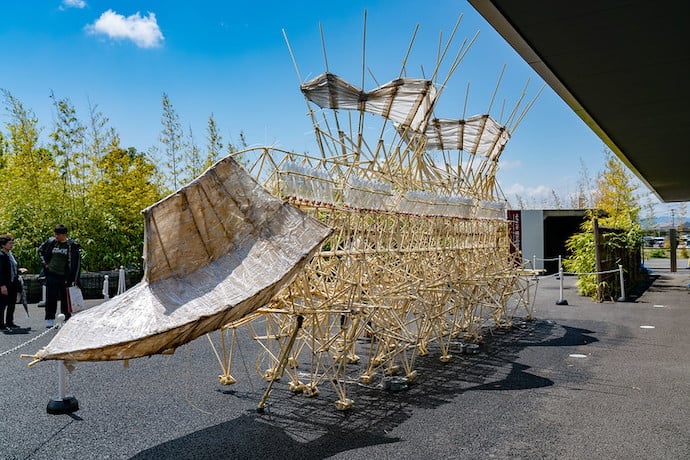Like the first thought you have when you wake up, the first lesson of each year can really set the tone for the months to come. I try to be very deliberate about choosing the first glimpse students get in my class. I see this as the first impression of a good student-teacher relationship.
This year, I am focusing more on design, so I began by introducing my students to Strandbeests, large wind-powered PVC pipe beach sculptures. The artist that creates these sculptures, Theo Jansen, has been toiling away on the beaches of the Netherlands building these machines for many years. Lined with dozens of legs rotating on cams around a central shaft, the sculptures walk across the beach powered only by sails attached to tall poles.
While he has received quite a bit of fame recently, for many years Jansen was building these “beach animals” in obscurity. Beyond being engineering marvels I see the Strandbeests to be a great example of innovation, persistence, and design. I also saw this as a perfect way to stretch my students’ imagination.
In an interview with Adam Savage, Jansen refers to his designs as not just an innovation, but his “mental children”. This seemed like a novel way to describe the process of innovation, so it became the center of our lesson. Just like real children, an innovation or a “thought child” requires years of care before it can walk on its own. In old videos from the early 90s, you can see Jansen struggling just to keep his beests upright and moving forward. However by the late 90s, his designs were intricate and towering above their creator on the beach.
If designs are like children, at what point does an innovation evolve beyond its creator to being something independent in the world? As my students discovered, something interesting happened to Theo Jansen and his Strandbeests in the late 90s and early 2000s. As his designs became ever increasingly inventive and impressive, they caught the eye of artists, engineers, and designers, and fame came quickly. Now his works are exhibited in museums around the globe, and Theo is no longer the lone man on the beach. After he put diagrams on how to build the legs and cams that drive his creatures on his website, designers as diverse as Japanese puzzle makers and high school students began replicating the sculptures and building new iterations.
In this way, Strandbeests are also a great introduction into version control and open source engineering. On his website Theo presents his early designs as an anthropological museum exhibit. With each version of the design, the zip-tie connections became stronger. In many ways he sees these beasts as having a spirit of all their own. Since my classes will be learning about forking and open source software in our classes this year, I found this to be a perfect opportunity to start that process.
To stoke their creativity, I asked my students to delve into their imaginations and to find some sort of “beest” to design. We made sketches based on Dr. Seuss characters, and designed creatures out of popsicle sticks. They would ask on occasion, “Does this have to have a purpose?” and I would always say no. True imagination shouldn’t need any explanation. Once they settled on a design, we brought their creatures to life using CAD and our 3D printing lab. Then, to encourage the idea of forking, students came up with iterative designs based on each other’s work.
In many ways, I wanted my students to make the connection that this is the goal of innovation. To take an idea that springs from the imagination and bring it out into the world. Given enough care and attention, it can live a life on its own and continue to grow and evolve with generations.
Learn More
Wallace & Grommit’s World of Invention: Strandbeests
https://www.youtube.com/watch?v=HSKyHmjyrkA
Building a beest fit for the beach
https://www.sciencefriday.com/articles/building-a-beest-fit-for-the-beach/
Theo Jansen
https://en.wikipedia.org/wiki/Theo_Jansen
Developing Strandbeests
Adam Savage meets Strandbeests
https://www.youtube.com/watch?v=U02qqB-2nbs
Walking bicycle
https://www.designboom.com/design/walking-bicycle-carv-theo-jansen-strandbeest-12-17-2019/
Meet the beests
https://www.exploratorium.edu/strandbeest/meet-the-beests
Strandbeest kits
Theo Jansen – TED talk
https://www.ted.com/talks/theo_jansen_my_creations_a_new_form_of_life
Top Ten Human Powered machines
https://www.youtube.com/watch?v=uhm3XkW3srI”
Playa Crawler
https://www.vice.com/en/article/435xz3/strandbeest-wheelchair-burning-man
Strandbeest Kit
Build a Strandbeest
https://www.sculpteo.com/blog/2017/08/09/3d-printed-robot-how-to-build-a-strandbeest/

